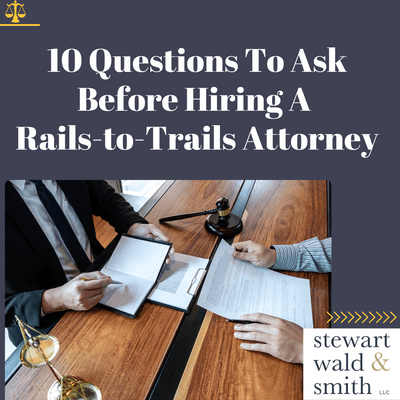
You may have heard some news in your community about the inactive railroad next to your property. You may have heard that the quiet railroad corridor that hasn’t seen a train in decades is going to be transformed into a recreational trail that would invite the general public into your back yard. Or maybe you received a letter from a law firm telling you about your rights when it comes to a rail-trail conversion along your property.
Any of these scenarios can get landowners thinking about what to do when it comes to hiring an attorney to represent them and protect their property rights.
The attorneys at Stewart, Wald & Smith have protected the rights of landowners for decades. We have spoken to many clients who are confused, uncertain, and concerned when it comes to understanding the Trails Act and hiring an attorney for a rails-to-trails case. Some landowners are not aware that they own the land within a railroad right-of-way or railroad corridor. In most states, landowners are presumed to own to the centerline of the railroad right-of-way. You can learn more about the centerline presumption here.
Finding a good attorney is hard. How can you be sure you are hiring the best? How do you know how much success a firm has had with these types of cases? How legitimate is the firm? To feel confident in your decision in hiring an attorney, you need to ask questions.
Choosing the right attorney is important. To make the right choice, you should ask the following questions.
1. Can you explain why I have a claim – why would I get money for land I don’t even use?
Rail-trail conversions are possible thanks to the Trails Act. This is an act of Congress that allows railroads to offer up their railroad rights-of-way for recreational use in lieu of abandonment. Normally, when a railroad abandons its railroad corridor, the landowners on either side of the corridor are supposed to gain possession and control of the land. But the Trails Act prevents that from happening and instead authorizes the land for use as a recreational trail. Federal courts unanimously say this is a taking of land and that private landowners can obtain compensation from the federal government. That is the basis of the claim.
An in-depth explanation can be found on our blog: The Landowners’ Guide to the Trails Act, or you can watch the video explanation.
2. What are the chances of success, and what do I get if my claim succeeds?
Stewart, Wald & Smith makes it a practice to investigate their potential cases before reaching out to landowners. Yet, even if a landowner’s claim is eventually dismissed or loses outright, the landowner does not owe anything. The firm takes on the risk, and the landowner never owes anything.
The compensation landowners receive depends on the quantity and quality of land that the government takes from you. The quantity is usually based on the length of your land next to the former railroad corridor and how many feet go from the edge of your land to the centerline of the railroad corridor. Professional appraisers provide opinions about how much the area is worth, based on comparable sales of similar land in the area. In addition, appraisers determine whether the presence of a recreational trail reduces the overall value of all of your land. Finally, the government pays interest on the amount owed from the day of the rail-trail conversion until the day it pays you.
3. What’s your experience with these kinds of cases?
The attorneys at Stewart, Wald & Smith have a combined 100+ years of litigation experience. They have been practicing Rails-to-Trails litigation for well over a decade and were the first attorneys to turn Rails-to-Trails cases into a nationwide practice.
Stewart, Wald & Smith is the only law firm in the country that is fully dedicated to Rails-to-Trails cases, and have won the most Rails-to-Trails cases and for the largest amounts.
When speaking with a firm, pay close attention to the number of Rails-to-Trail cases they have successfully litigated verse other types of cases.
For example, Stewart, Wald & Smith proudly displays their Rails-to-Trails cases online with a map of the nation, and a track record - showcasing recoveries of over $390,000,000 in Rails-to-Trails litigation.
4. What should I be most concerned about?
The number one thing you should be concerned about is ensuring your rights are protected. Rail-trail conversions not only take property that belongs to you, they also have the potential to reduce the value of your home or business. This means that the law firm you hire should be committed to your claim and do what is necessary.
Do your homework: Research the website of the law firm to get information on their successes, and their trial experience, and read their client testimonials. Call the office that contacted you. You are committing your claim to your law firm, and the firm should be just as committed to you.
5. What would I owe in legal fees?
You should closely review the contract. Will the firm charge an hourly rate or collect a contingency fee from the recovery? Does the firm require a retainer? Are you going to be responsible for costs and fees if your case is unsuccessful? What costs and fees are your responsibility, even if the case succeeds?
At Stewart, Wald & Smith, our contracts ensure that you have no risk of ever having to pay us any money unless we recover money for you. If we recover nothing, you pay us nothing, and you do not owe us for expenses. If we do recover money for you, our fee will be a percentage of your recovery or our hourly rate, whichever is higher (important note - those hourly rates are actually paid by the government). In addition, the government pays the litigation expenses. If you have questions about our contract, please don’t hesitate to contact us.
6. What if I sold my property and don’t own the land next to the railroad anymore?
If you are the owner on the date the government authorized conversion to a trail, then the claim stays with you. It does not transfer to the next owner.
If you are unsure if you would have a claim because you no longer own the land, call us to discuss your ownership status. Any firm that practices Rails-to-Trails litigation should give you a clear and concise answer to your question right away.
7. What is the process?
Litigation can take a long time. In Rails-to-Trails litigation, the typical life cycle of a case is 3-5 years, although some are quicker and some take longer.
We regularly update our clients as the case progresses.
Although every case is different, a typical Rails-to-Trails case goes through the following process:
- The railroad files a petition to abandon a line, and a trail user expresses interest to acquire the line for a recreational trail.
- The United States Surface Transportation Board issues a Notice of Interim Trail Use (“NITU”) that blocks landowners from using their land within the railroad right-of-way. This triggers the claim.
- The railroad and the trail user negotiate the transfer of the line for a recreational trail.
- Attorneys exchange documents with the government attorneys.
- Liability is established.
- Appraisers are hired, and they appraise each parcel of land.
- Appraisals are exchanged with the government.
- The case is settled or the case proceeds to trial.
8. Why do I need a Rails-to-Trails Attorney?
If you do not file suit, you will not be paid compensation. The government will not voluntarily pay you for the land that it takes for the rail-trail conversion.
Rails-to-Trails litigation is an area that not many attorneys practice. The attorney must be admitted in the United States Court of Federal Claims. The attorneys at Stewart, Wald & Smith have decades of experience in the United States Court of Federal Claims and with the judges that preside over the Court.
It is also important to hire an attorney with knowledge about land values and land appraisals specific to a rail-trail conversion. Rail-trail appraisals are unique. We work closely with appraisers who are proven to be knowledgeable in Rails-to-Trails type appraisals.
9. Will bringing a case affect the plans for a trail?
No. Rails-to-Trails cases are not adverse to the trail or the entity constructing the trail in any way. The cases are completely neutral toward the trail and trail user and will not change anything on the ground. The only adversary is the federal government, and these cases simply say that if the government is going to authorize the land in the former railroad corridor for conversion to a public trail, then the government should have to pay for it and compensate the landowners on whose land the trail is placed. The cases are enforcement of landowners’ Constitutional rights. The only two outcomes of the cases are that a landowner receives compensation or does not receive compensation.
10. How can I reach you during the case?
We urge our clients to reach out to us anytime via telephone, email, or our website. We pride ourselves in communicating with our clients and being available to answer questions at any point in the case.
Stewart, Wald & Smith speaks more about client satisfaction and what sets us apart from other firms in our video.

